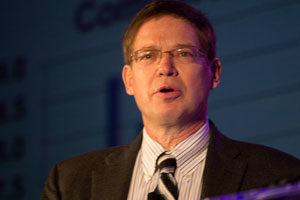CattleFax senior analyst Kevin Good, speaking at the NCBA Industry Convention in Tampa, said after another year of a declining beef herd in 2012, there is a “smoothing effect in liquidation” apparent in the most recent data. Those indicators show that producers are trying hard to prepare strategies to keep adding to herds.
“If we were to expect to see beef cow industry stabilize and expand, we’ve got to expect cow harvest rates to drop by about 1.2 million head over the next couple years,” said Good. He added that U.S. heifer slaughter percentage of total beef slaughter has declined the past few years – a good indicator that expansion is knocking at the door.
Geographically from 2010 to 2013, expansion has been seen in the Pacific Northwest and the Northern Plains, since drought has had less impact in those areas. The biggest liquidation remains in the Southern and Central Plain regions, with Texas being hit hardest with a 20 percent reduction in the beef cow herd over a 24-month period.
For cattle on feed reporting, Good said the supply of feeder cows and calves outside of feedlots is above levels from early 2013. Although there was a smaller calf crop in 2012, the placements also dropped off - creating a cattle-on-feed inventory on Jan.1 that was down about 800,000 head.
But Good said that trend would turn around, possibly by the end of the first quarter.
“The availability is there,” Good said. “Those placements in turn could create that larger supply there in the summer for a fed cattle market standpoint.”
Tight supply margins
The recent news of Cargill’s closing a packing plant in Plainview, Texas was hardly a surprise, Good said, considering the overcapacity seen in packing and feeding sectors for some time. Between 2000 and 2010, a 1 percent annual drop was seen in steer and heifer slaughter rates.
In 2012, 900,000 fewer fed steers and heifers were slaughtered. “What did we take offline with the Plainview plant? It was roughly worth a million head at capacity wasn’t it? That’s nothing more than balancing up supply and demand.”
Looking to 2013, CattleFax projects harvest rates will be down “about a half-million head,” Good said. Going into 2014, you can expect continued declines in relation to the size of the herd. “If we get more moisture, you’ll see expansion and that trough gets tighter as you keep more heifers back.”
Producers can also expect to see higher average carcass weights. The average weight has gone up about 6 pounds a year over the past 30 years, Good said, and 2012 went even higher with that average weight going up 18 pounds.
Looking ahead those weights “will increase at or a tick above that long-term average for 2013,” Good said, adding that from an overall supply side, there are many factors friendly to the side pushing high prices.
Potential demand risks
Good said today’s economy poses a growing number of risks that threaten the consumer demand outlook.
First and foremost is the 1 percent drop forecast for U.S. per capita disposable personal income. Good said with the economy stalling, and the 2 percent tax holiday now gone, “automatically more workers in the U.S. have less money to spend.”
“We’d be in the camp that for the consumer domestically, that he’s going to have less consumable income in 2013 than 2012.”
Retail prices will also continue to push upward in 2013, Good predicted. Since 2007, beef retail prices have jumped 24 percent, with poultry up 14 percent and pork up 21 percent.
“We were the highest price protein to begin with, and we continue to widen that gap,” he said, adding that retail prices are expected to go up 4 percent in 2013.
Segments of the restaurant performance index are also mixed, with high-end restaurants doing “OK,” Good said, but there is “concern for casual dining, and to a lesser degree for fast food. Some of those numbers are starting to decline. There are some things showing that maybe the consumer is holding onto his wallet tighter than we’d like to see.”
Wider choice-select spread
Good said the difference today, as opposed to a year ago, between ungraded carcasses and prime carcasses is roughly $60 per hundredweight.
“The premiums drive our grids and we’re optimistic that the spreads in 2013 will be a little bit wider than in 2012.”
Wholesale demand is expected to be down 1 to 2 percent, Good predicted, with fed demand dropping down 2 to 3 percent.
Good predicted that the annual average price of $126, above the average last of $123. That range frames a healthy outlook for the use of futures on fed cattle that run around $130.
“Let’s recognize we have to step back as an industry, look at the supply, the demand, and not be overwhelmed by the emotion that we have because we’ve got 135 breakevens,” Good said. “Just because we’ve got (those) doesn’t mean the market is going to get there.
We have to be more realistic about the market even though we are expecting higher averages for the year.”
Good concluded by giving vastly different profitability estimates for segments in the beef industry. The feeding industry, he said, “is going to continue to be a negative margin for the year. They continue to be more engaged in the risk management sector of our business to make ends meet.”
Stockers and backgrounders will see tighter profitability that what’s been seen over the past 10 years. “It’s a margin business but will generally be profitable for 2013.”
The cow-calf business will be “extremely positive, assuming how much is held nearby to keep those calves going, and on what the moisture conditions are like.” ![]()







